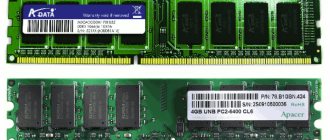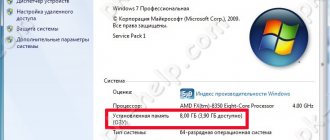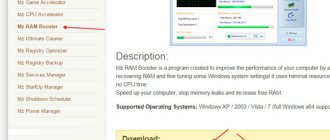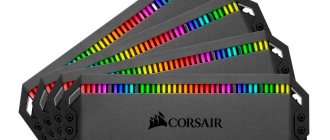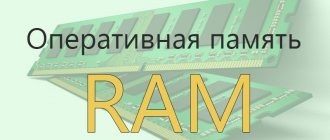What are DDR2 and DDR3?
The appearance of DDR2 caused a huge sensation not only among representatives of large IT companies, but also among users who simply did not want to give up the standard version of DDR. If we compare the second version of RAM with the standard one, it should be noted that DDR 2 is capable of transferring data across both slices. In addition, their difference comes down to the fact that DDR 2 can boast of having a much faster bus. By the way, the procedure for transferring data to them can be performed simultaneously, and from four places at once. In view of the above, we can confidently say that the data transfer speed of DDR 2 will be several times higher than that of the previous generation.
In addition, such RAM is characterized by relatively low power consumption and fairly fast cooling. DDR 2 seemed to be the most efficient, until the existence of DDR3 became known.
In the case of such RAM, there is a decrease in the supply voltage of the cells. The creators of DDR 3 somehow incredibly managed to reduce power consumption by as much as 15 percent . In addition to standard varieties of DDR 3, slightly modified versions are also available on the modern market. They are marked with the letter “L”, which means that this RAM model can boast of having an even greater energy saving indicator. The bandwidth of DDR 3 significantly exceeds those provided in the case of any previous RAM models. However, now DDR 3 can no longer be called the most efficient type of RAM, since relatively recently, DDR 4 announced itself, which, according to the official statement of the manufacturer, should surpass all previous generations.
How to differentiate and compatibility
To correctly determine which standard a module belongs to, you need to know how DDR3 differs from DDR3l. Let's figure out the difference between DDR3 and DDR3l in terms of labeling.
DDR3 modules are usually marked PC3
, while PC3L is installed on low-voltage memory. In addition, in some cases, the supply voltage is indicated, 1.5v for ddr3 and 1.35v for ddr3l, respectively.
Due to the same form factor and key placement, it is possible to insert a DDR3 module into a socket on a motherboard designed for DDR3L, or vice versa. What can such inattention lead to?
It is highly not recommended to put ddr3l and ddr3 memory together. If the motherboard is designed to install low-voltage RAM, then a regular module may simply not work or may malfunction.
If a memory module is designed for a voltage of 1.5 volts, but only receives 1.35 volts, then it is very likely that it will behave unstable, causing regular freezes and sudden system reboots. However, it is quite possible that the RAM stick will work normally. Especially if you slightly increase the timings and reduce the frequency, then the chance of uninterrupted operation will increase, albeit at the cost of some reduction in performance. But is it worth the risk?
It would seem that raising the voltage is enough, because many motherboards allow this. Yes, then the situation will be quite typical for overclocking, when for normal operation you have to increase the voltage.
It is worth noting that Intel processors, starting with the Skylake generation, are designed only to work with low-voltage DDR3l memory. According to company representatives, in the long term, running processors of 6th and later generations of the Core architecture with memory designed for a voltage of 1.5 volts can harm the CPU.
It turns out that in many cases it is possible to make a DDR3 module work with a motherboard and processor designed for DDR3l. But, as a result of all the efforts made, it is easy to get an unstable computer. DDR3 memory can hardly be considered a universal solution for any configuration, which is also how it differs from DDR3l.
If you want to install additional RAM in a laptop, then be very careful about its choice. Many laptops have SO-DIMM DDR3L memory with lower power consumption, as this increases its battery life.
The best way to purchase the memory you need is to open your laptop, take out the memory module and write down its characteristics or take it to the store. You can also use software to view the hardware of your computer (such as CPU-Z) and go to the SPD tab
.
The second option is to use a module designed for low voltage in an old motherboard that supports DDR3. Based on the requirements of JESD79-3-1A.01, the document that regulates the DDR3L standard, any module must be backward compatible with regular DDR3.
That is, the difference between DDR3 and DDR3l is that low-voltage memory can work in any board, and standard-voltage RAM can only be used in boards designed for it.
Comparison of DDR 3 and DDR 4
I think you can guess that DDR 3 and DDR 4 are RAM standards that, unfortunately, cannot be interchangeable or compatible. In addition, they differ in the speed of their own work, as well as in some frequency indicators. So, if the maximum frequency of ordinary DDR 2 is only 800 MHz, then in the case of DDR 3, this figure increases to 1600 MHz.
It is not recommended to install DDR 2 and DDR 3 on the same motherboard, as they are completely incompatible. These two memory standards also differ in that DDR3 consumes much less power and also cools much faster. By the way, at the moment there are so-called hybrid motherboards on sale, the main feature of which is that they have connectors for both types of RAM. However, it should be taken into account that they can only be used separately from each other.
DDR 2 and DDR 3
The main differences between DDR 2 and DDR 3 are as follows:
- The main distinguishing feature of these two memory standards is that they have completely different slots and, due to their presence, it is impossible to combine them with each other.
- DDR 3 has a much higher clock speed. In the new version it is 1600 MHz, and in the previous version it is only 800 MHz.
- Unlike its previous version, DDR3, boasts much higher bandwidth and much lower power consumption.
Indeed, in some situations it is completely inappropriate to replace the old DDR2, because in the vast majority of cases, especially considering how a significant part of PC users spend their leisure time, that will be enough. At the same time, we should not forget that DDR2 and DDR3 are completely different types of RAM and, due to the presence of so many distinctive features, it is completely stupid to confuse them with each other. By the way, the DDR4 memory standard has now appeared, which, like all its former analogues, will have a whole list of all sorts of differences. At the same time, it will cost much more!
Hi-techComment
How to overclock DDR3 RAM
The performance of RAM is mainly affected by two parameters: frequency and timings. You can overclock using one or the other. Or you can even find an ideal stable solution. maneuvering meanings between the two.
Selecting an overclocking method based on frequency and timings
You can increase the memory operating frequency using FSB - increasing the system bus frequency. This increases overall productivity. In different BIOS versions they can be indicated as a ratio of 1:1, 1:2 or as a percentage. If the motherboard supports built-in profiles, then the task is greatly simplified. It is worth setting the frequency values manually gradually, in small steps. After each change, you need to boot into the operating system and check it for stability in productive games or tests. If the system is stable, you can try to increase it further.
Standard BIOS interface
Increasing performance using timings can also be done from under the BIOS, or using special utilities directly in the operating system. The main 4 timings have the greatest impact on performance - these are CL, tRCD, tRP, tRAS. They are indicated in the specifications for RAM. To increase productivity they need to be reduced. This should be done in the same way as with frequency gradually, checking the stability of the system each time.
You need to set the values gradually, checking stability each time
It’s interesting that sometimes not the fastest memory timings at different frequencies can produce good overall results. Therefore, after finding the ideal stable value, you can play a little with frequencies and timings in different directions and compare performance.
How to set values and change settings
To properly tune performance, you need to change the frequency or timing parameters. This can be done through the BIOS or using programs. Let's look at both points in more detail.
Via BIOS interface
There are many types of BIOS, and the names of the items in them can be different. To change the frequency, you may need the “Memory Frequency”, “CPU Clock Ratio” or similar items. In general, we recommend that you choose an overclocking method based on your motherboard model by finding its specifications and setup guides on the manufacturer's official website.
Modern BIOS - UEFI are easy to use
To set timing values, you will have to look in the BIOS for something like DRAM Timing Selectable or DRAM Configuration. Typically these items are set to Auto mode, so you need to switch them to Manual. This will unlock the existing timings for editing. The 4 main ones that most affect performance are usually separated into a separate block. Now you can change them, rebooting each time and checking the system for stability.
Through a program for overclocking DDR3 RAM
In fact, programs that could really fully overclock RAM from Windows are rare. For the most part, these are utilities for overclocking the system bus frequency. We can only highlight the MemSet program, which is capable of changing timings on the fly from under the operating system. However, you should first familiarize yourself with the list of systems it supports, since it may not work with everyone.
This is what the MemSet program looks like
Therefore, it is difficult to find a universal tool for overclocking the entire range of systems on the market. We recommend using the software that comes with the motherboard, as many modern manufacturers are trying to simplify the interaction of their products with users. This will allow you to use an overclocking technique optimized for a specific PC build.
Monitoring performance with DDR3 RAM test software
After each change in system parameters, it is necessary to monitor how stable its operation is. You can check this using games and special utilities. There are several of them. The simplest of them is MemTest. This little program checks RAM for write/read errors. Its interface is so simple that you don’t even need special skills to use it. It is enough to enter the required amount of memory to be tested or leave all that is available and click Start Testing. After checking, it will report what percentage of errors were found during testing.
The program is as small as its window
A separate module for checking the stability of the system as a whole also contains AIDA64, a program for analyzing and monitoring the condition of equipment and the system. In the settings, you can specify which sections need to be checked: RAM, processor or graphics adapter.


